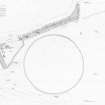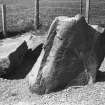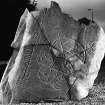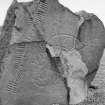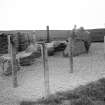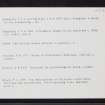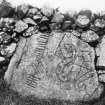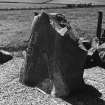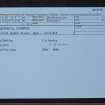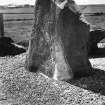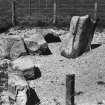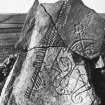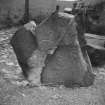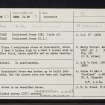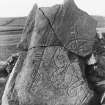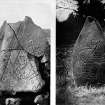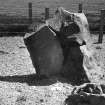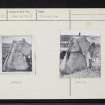Brandsbutt, Inverurie, Symbol Stone
Ogham Inscribed Stone (Pictish), Pictish Symbol Stone (Pictish)
Site Name Brandsbutt, Inverurie, Symbol Stone
Classification Ogham Inscribed Stone (Pictish), Pictish Symbol Stone (Pictish)
Alternative Name(s) Brandsbutt Stone
Canmore ID 18894
Site Number NJ72SE 23
NGR NJ 75992 22403
Datum OSGB36 - NGR
Permalink http://canmore.org.uk/site/18894
- Council Aberdeenshire
- Parish Inverurie
- Former Region Grampian
- Former District Gordon
- Former County Aberdeenshire
Brandsbutt, Inverurie, Aberdeenshire, inscribed Pictish symbol stone
Measurements: H 1.06m above ground, W 1.27m, D 0.91m
Stone type: whinstone
Place of discovery: NJ 75992 22403
Present location: in a small enclosure near the junction of Brankie Road and Gordon Terrace in the north-west area of Inverurie.
Evidence for discovery: the stone was broken up and used to build a field dyke at some time prior to the late nineteenth century. The large lower portion was recorded in the wall in 1899, and when shortly afterwards the wall was dismantled other fragments were found. The fragments were reassembled and cemented together sometime prior to 1950.
Present condition: despite its history of vandalism, the surviving carving on the stone is in good condition.
Description
One broad face of this originally substantial boulder is incised with two Pictish symbols, a crescent and V-rod above (and probably touching) a serpent and Z-rod. To the left of the symbols is incised an ogham inscription, reading IRATADDOARENS, possibly a personal name.
Date range: seventh century.
Primary references: ECMS pt 3, 506-7; Fraser 2008, no 7.
Desk-based information compiled by A Ritchie 2019
Field Visit (11 March 1964)
The stone is as described above.
Revised at 1/2500
Visited by OS (NKB) 11 March 1964
Desk Based Assessment (1964)
The Class I sculptured stone at Brandsbutt, which measures 3 feet 6 inches high by 4 feet 2 inches wide by about 3 feet thick, bears symbols and an ogham inscription.
J R Allen and J Anderson 1903
The Brandsbutt Stone was broken up to build into a field dyke, but the pieces have now been put together.
V G Childe and W D Simpson 1961.
The Brandsbutt Class I stone is decorated with a cresecent and V-rod and a serpent and Z-rod symbol, both incised, as well as being marked by a line of Ogams which are certainly contemporary with the symbols. It is a matter for regret that this stone was broken and partly lost in the past; and for congratulation that the remains have now been reassembled and are under guardianship.
R W Feachem 1963.
Information from OS.
Field Visit (1980)
A symbol stone of dark whinstone, 1.06m x 1.27m x 0.91m bearing a sepent and Z-rod, and crescent symbol. The stone once made up a field-dyke but has now been pieced together, to reveal an ogam inscription.
Visited by R Jones 1980.
Photographic Survey (December 1982)
Field visit by Grampian Regional Council archaeologists. (GRC/AAS ground photography listed).
NMRS, MS/712/72, visited December 1982
(GRC/AAS ground photography listed).
NMRS, MS/712/72, visited December 1982 and 23 August 1990.
Publication Account (1986)
A great, grey slab, once broken up but now restored, bearing an incised crescent and V-rod, a fine, scaley serpent and Z-rod with simple terminals, all carved in a broad confIdent line. Running up the left hand side of the stone is a typical Pictish ogam inscription in which the guide-line has been drawn in. It can be transliterated IRATADDOARENS, which may be similar to the Newton House stone (N] 662297) IDDARRNNN. This has been linked with Eddarrnonn, a possible rendering of St Ethernanus. It reinforces the interpretation of the symbol stones as some form of personal memorial.
The stone is adjacent to the site of a stone circle, now marked out in the grass.
Information from ‘Exploring Scotland’s Heritage: Grampian’, (1986).
Photographic Survey (23 August 1990)
Field visit by Aberdeenshire Archaeology Service. (GRC/AAS ground photography listed).
NMRS, MS/712/72, visited 23 August 1990.
Publication Account (1996)
A great, grey slab, once broken up but now restored, bearing an incised crescent and V-rod, a fine, scaley serpent and Z-rod with simple terminals, all carved in a broad confident line. Running up the left hand side of the stone is a typical Pictish ogam inscription in which the guideline has been drawn in. It ca n be transliterated IRATADDOARENS, which may be similar to the Newton House stone (N] 662297) IDDARRNNN. This has been linked with Eddarrnonn, a possible renderin g of St Ethernanus. It reinforces the interpretation of the symbol stones as some form of personal memorial.
The stone is adjacent to the site of a stone circle, now marked out in the grass; two of the stones of the circle survive in the drystone dyke to the N.
Information from ‘Exploring Scotland’s Heritage: Aberdeen and North-East Scotland’, (1996).
Reference (1997)
Class I symbol stone : crescent and V-rod over a serpent and Z-rod with an Ogam inscription on the left.
A Mack 1997.






























